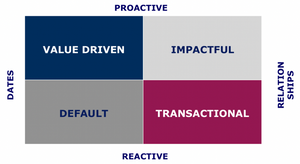Photo by Frankie Lopez on Unsplash
I'm in a pretty exciting place at the moment. In addition to working with my amazing women in finance, I have been writing my new book! And what I've come to realise is that when you're in the business of helping women in finance have greater impact and achieve their biggest goals, writing a book isn't a stand alone project. It's part of a bigger picture. Which involves speaking, marketing, delivering, synthesising....you name it, it's all part of the matrix. However, the benefit of writing a book like this is that it forces me to do a lot of strategic and big picture thinking about the work I do and the impact it has. A clear pattern has emerged in through this process and that is the power of proactivity. It is a foundational piece in all my programs, workshops and coaching conversations. It's proactivity in both mindset and behaviour and has broad application. And bigger than the pattern of models that have this proactive/reactive contrast embedded within it, I asked myself the question: what is going on here? Why does this contrast come up in many aspects of the work I do? Where I have landed on this, is the title of this article. Are you letting life happen to you? Are you letting your emails overtake your to-do list? Are you letting you boss dictate your working hours? Are you letting others schedule meetings at times that don't suit you? Are you letting 'the system' influence your leadership style? Are you letting others give you work and therefore shaping what you do and the potential impact you can have? If you have answered 'yes' to any of the above questions, then perhaps you are letting life happen to you. Which is a really easy thing to do when we're stressed, tired, uncertain or on the flip side, even when you're really keen. But let this pattern continue, and you are firmly putting yourself in the passenger seat of your own car. You are letting someone else take control of the steering wheel. So I think this is why a shift from reactive to proactive is so pervasive in the work that I do. Because it is so easy to slip into the passenger seat. Let's be honest, many of us naturally get into the passenger seat when we get into the car as a family. Why? I want to keep this article fairly straightforward today and share with you one of my key models around this. It is the model that I use with regards to the reactive/proactive shift as it relates to the 2 key resources at our disposal at work. Time and relationships.
The goal in using this model is to identify when we're in a reactive state quickly, and to know the steps that you need to take to move into a proactive state. In order for you to do each of these things is to know (a) what it looks like and (b) the steps you need to take.
A little about the model
Most of our work is dictated by a deadline. When in a reactive state and are given a deadline, we think 'Oh no, I don't have enough time!' and we default to the same behaviour and performance as we always have. It's very uninspiring but we're focused on doing the bare minimum to get through the deadline. When we are proactive about time and given a deadline, we say, 'Great. I'd be happy to work on that for you. Can I take 20 minutes of your time to understand more about the deliverable and the deadline?'. Very quickly you have set yourself up to get the real context of the deliverable, can understand the value of the deliverable, and can therefore influence the right work being performed at the right (i.e. more realistic) time. As it pertains to relationships, consider the interactions we have with our stakeholders and even, to some extent, with our colleagues. When we engage only when we need something, our relationships are limited to being transactional. When I need, or you need, we talk, but otherwise no dice. There is no depth which means there's no ability to leverage and influence. When we are proactive in our relationships at work, we can leverage, we can influence. We have impactful relationships. So when we get thrown a seemingly impossible challenge, we can have the difficult conversation that's needed to drive the right outcome.
You can apply this concept yourself
What I have outlined above is one important application around moving from reactive to proactive at work. I'd like for you to think about where else you feel you're not in control.
(A) What does that look like?
(B) What would it look like if you were proactive about it? Stretch this question out...think big. If you were ridiculously ahead of everyone else's thinking, what would that look like? What would you be doing? What would you be thinking? What would you be saying?
(C) What is the thing that you're missing? What is the difference between (A) and (B)?
(D) What are the steps that you need to take to get what you're missing? Reactive to proactive. It is one of the key steps to strategic leadership and taking control of your impact. Be proactive about being proactive.


